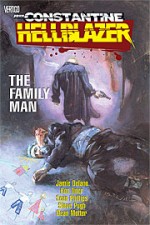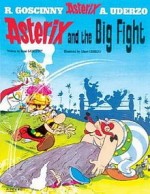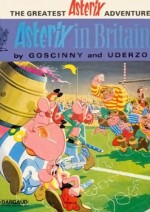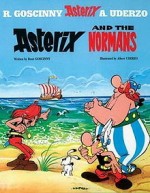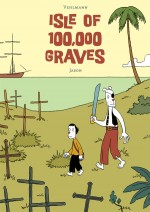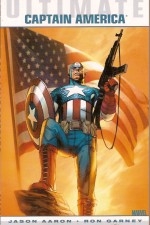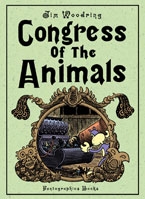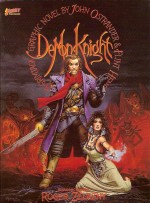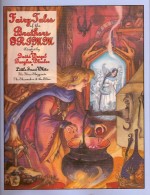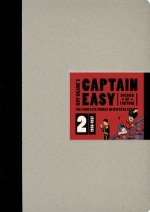
By Roy Crane (Fantagraphics Books)
ISBN: 978-1-60699-391-0
The comics industry evolved from newspaper strips and these circulation boosting pictorial features were, until relatively recently, utterly ubiquitous, hugely popular with the public and thus regarded as invaluable by publishers who used them as an irresistible sales weapon to guarantee consumer loyalty, increase sales and ensure profits. Many a scribbler became a millionaire thanks to their ability to draw pictures and spin a yarn…
It’s virtually impossible for us to today to understand the overwhelming power of the comic strip in America (and the wider world) from the Great Depression to the end of World War II. With no television, broadcast radio far from universal and movie shows at best a weekly treat for most folk, household entertainment was mostly derived from the comic sections of daily and especially Sunday Newspapers. “The Funnies†were the most common recreation for millions who were well served by a fantastic variety and incredible quality.
From the very start humour was paramount; that’s why we call them “Funnies†or “Comicsâ€, after all. From these gag and stunt beginnings, blending silent movie slapstick, outrageous antics, fabulous fantasy and vaudeville shows, came a thoroughly unique entertainment hybrid: Roy Crane’s Wash Tubbs.
Debuting on April 21st 1924 Washington Tubbs II was a comedic gag-a-day strip not dissimilar from confirmed family favourite Harold Teen (by Crane’s friend and contemporary Carl Ed).
Tubbs was a diminutive, ambitious young shop clerk when the strip began, but gradually he moved into mock-heroics, then through harm-free action into full-blown, light-hearted, rip-roaring adventure series with the introduction of pioneering he-man, moody swashbuckling prototype Captain Easy in the landmark episode for 6th May, 1929.
As the tales became increasingly more exotic and thrill-drenched the globe-trotting little dynamo clearly needed a sidekick who could believably handle the combat side of things, and thus in the middle of a European war Tubbs liberated a mysterious fellow American from a jail cell and history was made. Before long the mismatched pair were inseparable comrades; travelling the world, hunting treasure, fighting thugs and rescuing a bevy of startlingly comely maidens in distress…
The two-fisted, bluff, completely capable and utterly dependable, down-on-his-luck “Southern Gentleman†was something not seen before in comics, a raw, square-jawed hunk played straight rather than the buffoon or music hall foil of such classic serials as Hairsbreadth Harry or Desperate Desmond. Moreover Crane’s seductively simple blend of cartoon exuberance and compelling page-design was a far more accessible and powerful medium for action story-telling than the static illustrative style favoured by artists like Hal Foster (just starting to make waves on the new Tarzan Sunday page).
Tubbs and Easy were as exotic and thrilling as the Ape Man but rattled along like the tempestuous Popeye, full of vim, vigour and vinegar, as attested to by a close look at the early work of the would-be cartoonists who followed the strip with avid intensity: Floyd Gottfredson, Milton Caniff, Jack Kirby, Will Eisner and especially young Joe Shuster…
After a couple of abortive attempts starring his little hero, Crane bowed to the inevitable and created a full colour Sunday page dedicated to his increasingly popular hero-for-hire. Captain Easy debuted on 30th July 1933, in madcap, two-fisted exploits (originally) set before his fateful meeting with Tubbs.
Following a foreword from historian, archival publisher and critic Rick Norwood, ‘Stealing Color From Black and White’ a fascinating extended introduction by award-winning cartoonist Paul Pope and ‘Three Strip Monte’ a brief history of Crane’s career gambles by legendary strip historian Bill Blackbeard, this second volume (of four) really begins with ‘Gold of the Frozen North’ as the dour, sour soldier of fortune reaches the chilly snow-swept mining boom-town of Bugaboo.
Exhausted after his part in the war between Nikkateena and Woopsydasia (as seen in Roy Crane’s Captain Easy, Soldier of Fortune: The Complete Sunday Newspaper Strips volume 1) all Easy wanted was a meal and a bed, but his innate chivalry defending a bar-girl’s honour soon had him on the run from Nikky Eskota, the savage gang-boss who ran the town. He then compound the error by helping beautiful Gizzy escape the brute’s amorous attentions and escorting down the frozen river to trade her fathers’ diamonds.
Of course the wicked thug dispatched an army of heavies to stop them…
This spectacular icy wilderness adventure ran from 8th December 1935 to 19th April 1936, after which ‘The Hook-Nosed Bandit’ (4th April -8th August 1936) found the footloose hero heading to the trouble-soaked nation of Hitaxia where his penchant for trouble soon branded him a wanted criminal fugitive and landed him in the midst of a civil war. As usual a pretty girl was the immediate cause of his many woes and the method of his eventual escape… that and the advent of a bombastic new companion – unconventional millionaire inventor Mr. Belfry.
With Easy and Belfry’s daughter languishing in a Hitaxian jail the sagacious entrepreneur acted to end the crisis in unique manner with a handy shipment of pigs…
When the Belfry’s returned to America, Easy accompanied them only to become embroiled in a whirlwind cops ‘n’ robbers thriller as mobsters and businessmen alike tried to obtain by every means fair and foul ‘The Diamond Formula’ (16th August – 13th December 1936): the inventor’s new process for creating gems from coal or sugar…
After this wild and woolly New York set romp, Crane opted to take the theme into wholly different territory as Easy takes a mild-mannered old daydreamer from Belfry’s Gentleman’s Club on the Screwball comedy of ‘Dinwiddy’s Adventure’ – a fast-paced rollercoaster romp of intrigue, suspense and multiple practical jokes, with a twist and turn on every gloriously rendered page first published between 13th December 1936 and March 14th 1937…
The Club also provided the maguffin for ‘Lost at Sea’ (March 21st – May 9th 1937) as hen-pecked and harassed Benjamin Barton hired the laconic Southern Gentleman to engineer his escape from his ghastly social climbing wife and wastrel children. Barton even left them all his money: the rattled old goof simply wanted peace and quiet and perhaps a little fishing. Despite all Easy’s best efforts he didn’t get it…
Clearly on a roll with the emphasis on comedy Crane then introduced one of his wackiest characters in ‘The King of Kleptomania’ (16th May – November 14th 1937), as an audacious, freeloading, lazy, good-for-nothing hobo actually turned out to be Kron Prinz Hugo Maximillian von Hooten Tooten; the audacious, freeloading, lazy, good-for-nothing spendthrift heir to a European nation who was paid by the Dictator of Kleptomania to stay away and not seek his rightful throne.
Saving the bum’s life in America only caused the lovable leech to attach himself to Easy, but after going through his bi-annual stipend of $25, 000 in mere days “Hoot†decided to welsh on his deal with the despot and take back his country. Against his better judgement and to his lasting regret, Captain Easy goes along for the ride and is soon knee deep in ineptitude, iniquity and revolution…
With the war over Easy is stranded in Ruritanean Europe and stumbles into an espionage plot culminating in a welcome reunion and ‘The Firing Squad’ (21st November 1937 – 15th May 1938). Framed and jailed again Easy is to be shot so it’s luckily that the captain of the aforementioned executioners is his long-lost pal Wash Tubbs!
Risking life and diminutive limb to save his old pal, Wash also rescues sultry spitfire Ruby Dallas who promptly entangles them in her desperate tale of woe. Ruby was unfortunate enough to have witnessed a murder in America and has been on the run ever since. The killer was a prominent millionaire with too much to lose so he’s been hunting her ever since, but once the trio escape murderous cutthroats, slavers and assassins they soon settle his hash…
When he began the Sunday page Crane’s creativity went into overdrive: an entire page and vibrant colours to play with clearly stirred his imagination and the results were wild visual concoctions which achieved a timeless immediacy and made each instalment a unified piece of sequential art. The effect of the pages can be seen in so many comic and strips since – even in the works of such near-contemporaries as Hergé and giants in waiting like Charles Schulz.
These pages were a clearly as much of joy to create as to read. In fact, the cited reason for Crane surrendering the Sunday strip to his assistant Les Turner in 1937 was NEA Syndicate’s abrupt demand that all its strips be henceforward produced in a rigid panel-structure to facilitate them being cut up and re-pasted as local editors dictated. You can actually see the day that happened in this volume.
Whilst the basic drawing of Crane and Turner is practically indistinguishable the moment when the layout and composition were shackled stands out like a painful sore thumb. Crane just walked away from his playground, concentrating on the daily feature, until in 1943, contract expired he left the NEA to create the aviation adventure strip Buz Sawyer.
In this selection Roy Crane’s irrepressible humour comes perfectly into focus and this enchanting serial abounds with breezy light-hearted banter, hilarious situations and outright farce – a sure-fire formula modern cinema directors still plunder to this day.
Easy is Indiana Jones, Flynn (the Librarian) Carsen and Jack (Romancing the Stone) Cotton all at once and clearly set the benchmark for all of them.
This superb hardback and colossal second collection is the perfect means of discovering or rediscovering Crane’s rip-snorting, pulse-pounding, exotically racy adventure trailblazer. The huge pages in this volume (almost 14 ½ by 10½ inches or 21x14cm for the younger, metric crowd) provide the perfect stage to absorb and enjoy the classic tale-telling of a master raconteur.
This is storytelling of impeccable quality: unforgettable, spectacular and utterly irresistible. These tales rank alongside the best of Hergé, Tezuka, Toth and Kirby and unarguably fed the imaginations of them all as he still does for today’s comics creators. Now that you have the chance to experience the strips that inspired the giants of our art form, how can you possibly resist?
Captain Easy strips © 2011 United Feature Syndicate, Inc. This edition © 2011 Fantagraphics Books, all other material © the respective copyright holders. All rights


